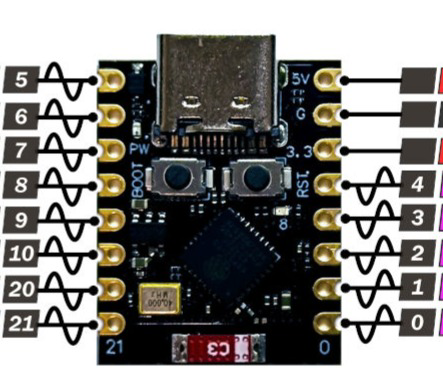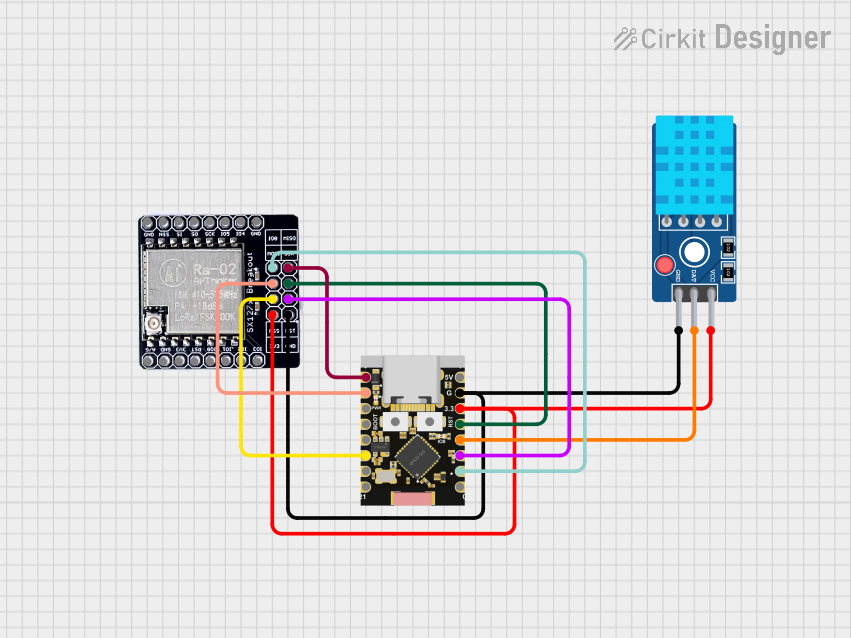
How to Use ESP32 C3 SUPER MINI: Examples, Pinouts, and Specs

 Design with ESP32 C3 SUPER MINI in Cirkit Designer
Design with ESP32 C3 SUPER MINI in Cirkit DesignerIntroduction
The ESP32 C3 SUPER MINI, manufactured by MIRANDA, is a compact and powerful microcontroller designed for IoT applications and embedded systems. It features integrated Wi-Fi and Bluetooth Low Energy (BLE) capabilities, making it an excellent choice for wireless communication projects. Its small form factor and robust performance make it ideal for space-constrained designs while maintaining high efficiency and versatility.
Explore Projects Built with ESP32 C3 SUPER MINI

 Open Project in Cirkit Designer
Open Project in Cirkit Designer
 Open Project in Cirkit Designer
Open Project in Cirkit Designer
 Open Project in Cirkit Designer
Open Project in Cirkit Designer
 Open Project in Cirkit Designer
Open Project in Cirkit DesignerExplore Projects Built with ESP32 C3 SUPER MINI

 Open Project in Cirkit Designer
Open Project in Cirkit Designer
 Open Project in Cirkit Designer
Open Project in Cirkit Designer
 Open Project in Cirkit Designer
Open Project in Cirkit Designer
 Open Project in Cirkit Designer
Open Project in Cirkit DesignerCommon Applications and Use Cases
- Smart home devices (e.g., smart lights, thermostats)
- Wearable technology
- Industrial IoT systems
- Wireless sensor networks
- Remote monitoring and control
- Prototyping and educational projects
Technical Specifications
The following table outlines the key technical details of the ESP32 C3 SUPER MINI:
| Parameter | Specification |
|---|---|
| Manufacturer | MIRANDA |
| Part ID | ESP32 C3 SUPER MINI |
| Microcontroller Core | RISC-V 32-bit single-core processor |
| Clock Speed | Up to 160 MHz |
| Flash Memory | 4 MB |
| SRAM | 400 KB |
| Wi-Fi | IEEE 802.11 b/g/n (2.4 GHz) |
| Bluetooth | Bluetooth 5.0 Low Energy (BLE) |
| GPIO Pins | 22 (multipurpose, including ADC, PWM, I2C, SPI, UART) |
| Operating Voltage | 3.3V |
| Power Supply Range | 3.0V to 3.6V |
| Current Consumption | ~10 µA in deep sleep mode |
| Dimensions | 18 mm x 21 mm |
Pin Configuration and Descriptions
The ESP32 C3 SUPER MINI has a total of 22 GPIO pins, which can be configured for various functions. Below is the pinout description:
| Pin | Name | Function |
|---|---|---|
| 1 | GND | Ground |
| 2 | 3V3 | 3.3V Power Supply |
| 3 | EN | Enable (Active High) |
| 4 | IO0 | GPIO0, ADC, UART TX |
| 5 | IO1 | GPIO1, ADC, UART RX |
| 6 | IO2 | GPIO2, ADC, PWM |
| 7 | IO3 | GPIO3, ADC, PWM |
| 8 | IO4 | GPIO4, ADC, I2C SDA |
| 9 | IO5 | GPIO5, ADC, I2C SCL |
| 10 | IO6 | GPIO6, SPI CLK |
| 11 | IO7 | GPIO7, SPI MOSI |
| 12 | IO8 | GPIO8, SPI MISO |
| 13 | IO9 | GPIO9, PWM, UART CTS |
| 14 | IO10 | GPIO10, PWM, UART RTS |
| 15 | IO11 | GPIO11, ADC |
| 16 | IO12 | GPIO12, ADC |
| 17 | IO13 | GPIO13, ADC |
| 18 | IO14 | GPIO14, ADC |
| 19 | IO15 | GPIO15, ADC |
| 20 | IO16 | GPIO16, ADC |
| 21 | IO17 | GPIO17, ADC |
| 22 | RST | Reset (Active Low) |
Usage Instructions
How to Use the ESP32 C3 SUPER MINI in a Circuit
- Power Supply: Connect the 3V3 pin to a 3.3V power source and GND to ground.
- Programming: Use a USB-to-UART adapter to connect the module to your computer. Connect:
- TX of the adapter to RX (IO1) of the ESP32 C3 SUPER MINI.
- RX of the adapter to TX (IO0) of the ESP32 C3 SUPER MINI.
- GND of the adapter to GND of the ESP32 C3 SUPER MINI.
- Enable Pin: Ensure the EN pin is pulled high to enable the module.
- GPIO Configuration: Configure the GPIO pins as needed for your application (e.g., input, output, ADC, PWM).
- Programming Environment: Use the Arduino IDE or ESP-IDF (Espressif IoT Development Framework) to write and upload code.
Important Considerations and Best Practices
- Voltage Levels: Ensure all connected peripherals operate at 3.3V logic levels to avoid damaging the module.
- Antenna Placement: Keep the onboard antenna area clear of metal objects or enclosures to maintain optimal wireless performance.
- Power Supply: Use a stable power source to avoid unexpected resets or performance issues.
- Deep Sleep Mode: Utilize the deep sleep mode to minimize power consumption in battery-powered applications.
Example Code for Arduino UNO
Below is an example of how to blink an LED connected to GPIO2 of the ESP32 C3 SUPER MINI using the Arduino IDE:
// Define the GPIO pin for the LED
#define LED_PIN 2
void setup() {
// Initialize the LED pin as an output
pinMode(LED_PIN, OUTPUT);
}
void loop() {
// Turn the LED on
digitalWrite(LED_PIN, HIGH);
delay(1000); // Wait for 1 second
// Turn the LED off
digitalWrite(LED_PIN, LOW);
delay(1000); // Wait for 1 second
}
Troubleshooting and FAQs
Common Issues and Solutions
Module Not Detected by Computer
- Ensure the USB-to-UART adapter is properly connected.
- Verify that the correct COM port is selected in the Arduino IDE or ESP-IDF.
- Check the drivers for the USB-to-UART adapter.
Wi-Fi Connection Fails
- Verify the SSID and password in your code.
- Ensure the router is operating on the 2.4 GHz band (not 5 GHz).
- Check for interference from other devices.
Program Upload Fails
- Ensure the EN pin is pulled high.
- Press and hold the RST button while uploading the code.
- Verify the correct board and settings are selected in the Arduino IDE.
Unstable Operation
- Use a stable and sufficient power supply.
- Check for loose connections or short circuits.
FAQs
Q: Can the ESP32 C3 SUPER MINI operate on 5V?
A: No, the module operates at 3.3V. Connecting 5V directly to the module may damage it.
Q: How do I reset the module?
A: You can reset the module by pulling the RST pin low momentarily.
Q: Can I use the ESP32 C3 SUPER MINI with Bluetooth and Wi-Fi simultaneously?
A: Yes, the module supports simultaneous use of Bluetooth and Wi-Fi, but performance may vary depending on the application.
Q: What is the maximum range of the Wi-Fi and Bluetooth?
A: The Wi-Fi range is approximately 30 meters indoors and 100 meters outdoors, while Bluetooth range is around 10 meters indoors.